Function
Aminomutases catalyze the exchange of hydrogen atom and an amine substituent on a neighboring carbon atom.[1]
- Phenylalanine aminomutase (PAM) catalyzes the reversible conversion of L-phenylalanine to ammonia and trans-cinnamic acid. Ala-Ser-Gly derived chromophore is a cofactor.
- Tyrosine-2,3-aminomutase (TAM) catalyzes the reversible conversion of L-tyrosine to 3-amino-3-(4-hydroxyphenyl)propanoate. Ala-Ser-Gly derived chromophore is a cofactor.
- Ornithine-4,5-aminomutase (ORA) catalyzes the reversible conversion of D-ornithine to (2R,4S)-2,4-diaminopropanoate. ORA cofactors are pyridoxal phosphate (PLP), cobamide coenzyme and dithiothreitol. ORA contains subunits S (ORAS) and E (ORAE). The ORAS forms a complex with lysine 5,6-aminomutase. The ORAE contains a balamin-binding motif.
- Lysine-2,3-aminomutase (LAM) catalyzes the reversible conversion of lysine to beta-lysine. LAM is a S-adenosyl methionine (SAM) radical enzyme. LAM cofactors are PLP, Zn ion and FeS4 cluster.
- D-lysine-5,6-aminomutase (DLAM) catalyzes the reversible conversion of D-lysine to 2,5-diaminohexanoate. DLAM cofactor is cobamide.
- Glutamate-1-semialdehyde 2,1-aminomutase (GSAM) catalyzes the reversible conversion of L-glutamate-1-semialdehyde to 5-aminovulinate. GSAM cofactor is PLP.
Function
PAM is part of the biosynthesis of polyphenol compounds.
TAM is part of the tyrosine metabolism.
ORA is part of the D-arginine and D-ornithine metabolism.
DLAM is part of lysine degradation.
GSAM is part of porphyrin and chlorophyll biosynthesis.
Disease
PAM is used for treatment of the genetic condition phenylketonuria.
Relevance
The reverse reaction of PAM is used for the production of L-phenylalanine used in the production of aspartime.
Structural highlights
TAM active site residues facilitate the deprotonation/reprotonation reaction. includes residues from both monomers in Tyrosine aminomutase (PDB code 2ohy).[1]
3D structures of aminomutase
Aminomutase 3D structures

